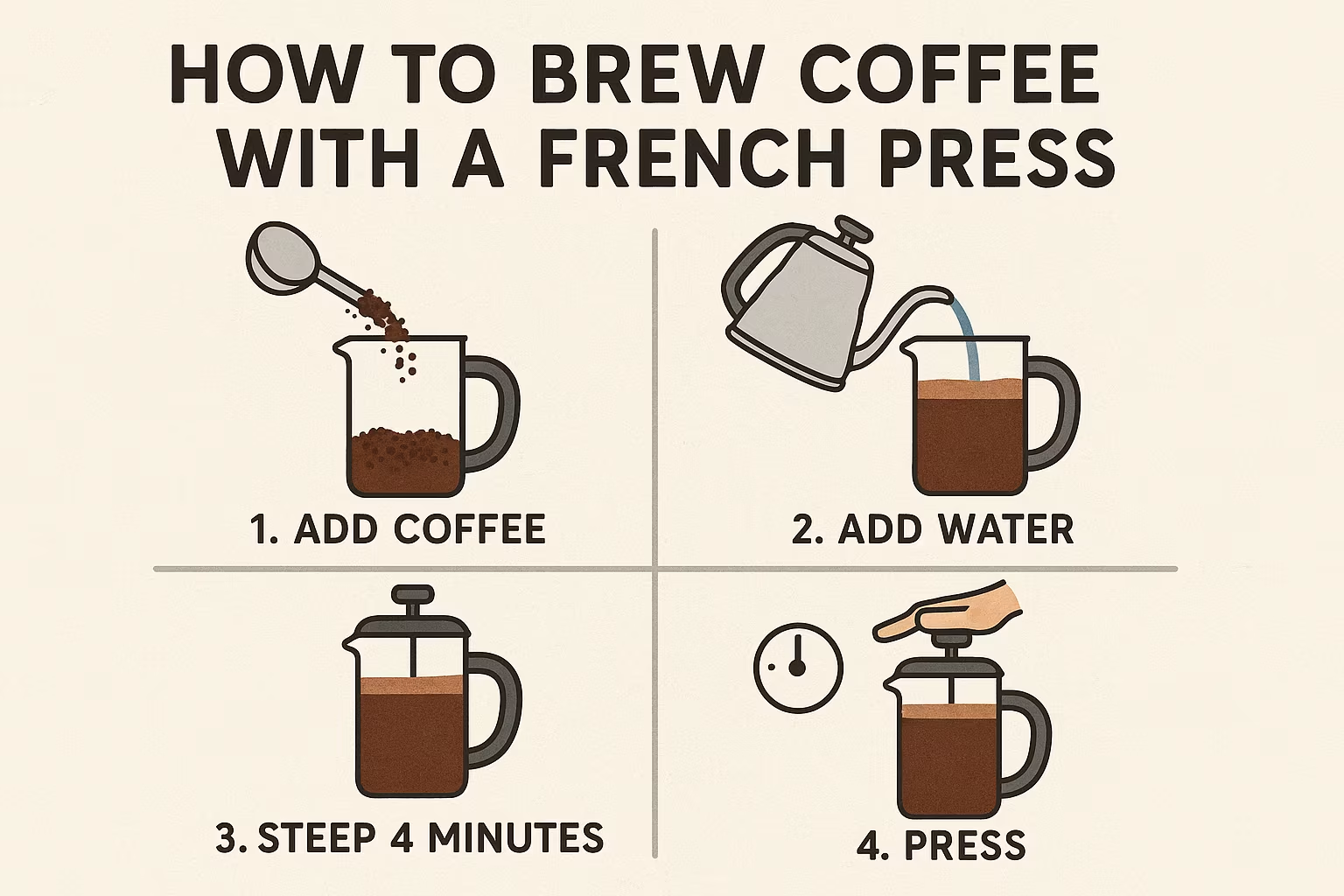Learn how to brew coffee with a French press step by step. Discover the perfect coffee-to-water ratio, grind size, and expert brewing tips to create rich, flavorful French press coffee at home.
How to Brew Coffee with a French Press Like a Pro
If you have ever sipped a cup of French press coffee, you’ll know why this brewing method has captivated coffee lovers for decades. The rich, full-bodied flavor, the aroma that fills the room, and the simple elegance of the process make it an art form as much as a daily ritual.
But here’s the secret: mastering how to brew coffee with a French press isn’t about being a barista—it’s about understanding a few key principles and following a precise yet enjoyable process.
“Life is too short for bad coffee.” – Unknown proverb, embraced by coffee enthusiasts worldwide.
This guide will walk you step by step through the French press brewing process, covering everything from the coffee-to-water ratio to the ideal grind size, and from avoiding common mistakes to pro-level tricks. Whether you’re brewing for yourself on a quiet morning in Paris or impressing guests in your kitchen in New York, you’ll soon brew like a professional.
Step-by-Step Guide: How to Brew Coffee with a French Press
When users search how to brew coffee with a French press, what they want most is a practical, clear, and foolproof guide. So let’s dive into the process—starting from the basics and building toward perfection.
What You’ll Need Before Brewing
To set yourself up for success, make sure you have the following:
French press (8-cup press is standard, but adjust based on servings)
Fresh coffee beans (medium-to-dark roasts often shine in French press)
Burr grinder (to achieve consistent coarse grind)
Hot water (ideally 195–205°F / 90–96°C for best extraction)
Scale (for accurate ratio: coffee to water)
Spoon or wooden stirrer
Timer (to control steeping)
The French press was patented by Attilio Calimani, an Italian designer, in 1929. Since then, it has remained a favorite among connoisseurs who value coffee that retains natural oils, offering a depth of flavor absent in paper-filtered methods like drip.
Choosing the Right Coffee-to-Water Ratio
One of the most critical factors in French press brewing is the ratio of coffee to water. Too much coffee, and your brew will taste muddy and bitter; too little, and it will be weak and lifeless.
Golden Ratio (recommended):
| Coffee (grams) | Water (ml) | Flavor Profile |
|---|---|---|
| 1:12 | Strong, bold, heavy body | |
| 1:15 | Balanced, smooth, versatile | |
| 1:17 | Lighter, tea-like clarity |
For beginners, a 1:15 ratio is a safe starting point—30 grams of coffee to 450 ml of water.
Expert tip: Always measure your coffee by weight, not volume. Coffee beans vary in density, and a scale ensures consistency every time.
This ratio is your foundation, but you can adjust based on your personal taste preference or the type of beans you use. For example, Ethiopian beans often shine with a lighter ratio, while Brazilian dark roasts benefit from a denser brew.
Mastering the Perfect Grind Size for French Press
Grind size is where many home brewers stumble. If your grind is too fine, you’ll end up with sludge and over-extraction; if too coarse, the water will pass through too quickly, leaving you with underwhelming flavors.
The ideal French press grind size is coarse, similar to sea salt.
Too Fine (Espresso grind): Bitter, cloudy, difficult to press.
Too Coarse (Cold brew grind): Weak, watery, lacking character.
Just Right (Coarse grind): Clean, bold, aromatic.
A burr grinder is highly recommended over a blade grinder because it produces uniform grounds, which leads to more consistent extraction.
Fun fact: Coffee guru James Hoffmann, World Barista Champion, emphasizes grind consistency as the “gateway to great French press coffee.”
Brewing Process: From Bloom to Plunge
Now comes the heart of the process. Brewing with a French press is not just pouring hot water over coffee—it’s a mindful sequence that brings out the best in every bean.
Preheat the French press: Swirl hot water inside, then discard. This maintains brewing temperature.
Add coffee grounds: Based on your ratio (e.g., 30 grams of coffee for 450 ml of water).
Bloom stage (30 seconds): Pour just enough hot water to saturate the grounds. Stir gently. This releases trapped CO₂, enhancing extraction.
Pour the rest of the water: Slowly fill the press to the top.
Steep: Place the lid on (plunger pulled up) and let it brew for 4 minutes.
Stir gently at 2 minutes: This ensures even extraction.
Press: After 4 minutes, press the plunger down slowly with steady pressure.
Serve immediately: Coffee left in the press continues to extract, leading to bitterness.
Pro Insight: Some coffee enthusiasts extend steeping to 6–8 minutes and skim the floating grounds before plunging. This variation often yields a cleaner, sweeter cup—worth experimenting with.
Common Mistakes to Avoid When Brewing with a French Press
Even seasoned brewers sometimes trip up. Here are pitfalls to avoid if you want café-quality results.
Using the Wrong Grind Size
One of the top mistakes is using pre-ground coffee intended for drip machines. These grinds are typically too fine, clogging your filter and leading to unpleasant sludge. Always grind fresh, and grind coarse.
Over-Extracting or Under-Extracting Coffee
Over-extraction: Happens when you steep too long or grind too fine. Result = bitter, harsh taste.
Under-extraction: Happens when you don’t steep long enough or grind too coarse. Result = sour, weak flavor.
Rule of thumb: Stick to the 4-minute mark and adjust slightly based on taste.
Not Cleaning Your French Press Properly
Neglecting to clean your press after every use can leave behind coffee oils that turn rancid and ruin the next brew. Always disassemble the plunger, rinse thoroughly, and wash with mild soap.
“Clean equipment equals clean flavor.” – A principle echoed by every professional barista.
Pro Tips for Brewing the Best French Press Coffee
Once you’ve mastered the basics, it’s time to level up your game with some professional tricks. These small details make the difference between a good cup and an exceptional one.
Water Temperature and Quality
Temperature: Keep it between 195°F and 205°F (90–96°C). Boiling water (212°F) scorches coffee; cooler water under-extracts.
Quality: Use filtered water if possible. Tap water with chlorine or hardness will affect taste.
Stirring and Timing for Maximum Flavor
After the bloom, stir gently to ensure even saturation. During steeping, resist the urge to over-stir. Let the coffee work its magic undisturbed.
Timing hacks:
Stronger flavor? Extend to 5 minutes.
Cleaner cup? Skim off the floating grounds before plunging.
French Press vs Other Brewing Methods
Coffee lovers are spoiled for choice today. Between drip coffee machines, pour-over devices, AeroPress, moka pots, and espresso machines, the French press has stood the test of time.
See more: How to Make Cloud Coffee Recipe Instagram-Worthy (Step-by-Step Guide)
French Press vs Drip Coffee
Drip coffee, especially when made with automatic machines, is a staple in American homes and offices. It’s convenient and consistent, but it comes with trade-offs. Paper filters in drip machines absorb the coffee’s natural oils, resulting in a cleaner but less full-bodied taste. In contrast, the French press preserves these oils, delivering a richer mouthfeel and deeper flavor profile.
French Press: Bold, full-bodied, aromatic, retains natural coffee oils.
Drip Coffee: Cleaner, lighter body, easy to make large quantities.
A 2018 survey by the National Coffee Association revealed that while drip coffee remained the most common at-home method in the U.S., French press ownership had grown significantly among younger demographics who value craft and authenticity over convenience.
French Press vs Pour-Over
The pour-over method, popularized by brands like Hario V60 and Chemex, is praised for its clarity and control. It produces a cup with delicate flavors and bright acidity, perfect for highlighting single-origin beans. But pour-over requires practice, precision pouring, and special filters.
The French press, on the other hand, is more forgiving and emphasizes body over clarity. Where pour-over feels like a laboratory experiment, French press feels like a rustic ritual.
Pour-Over: Crisp, bright, clean taste, but technique-dependent.
French Press: Heavy, textured, indulgent, simple for beginners.
Why French Press Stands Out
If coffee were music, espresso would be a powerful opera, pour-over a delicate violin concerto, and French press a soulful jazz performance—rich, layered, and improvisational. It brings out the “soul” of the bean in a way that resonates with those who see coffee as more than just caffeine.
“Coffee is a language in itself.” – Jackie Chan
At Lyoncafe (learn more at mtnlyoncafe.com), we emphasize the French press as the perfect bridge between craft and accessibility. It’s the brewer that allows newcomers to step into specialty coffee confidently while still satisfying the seasoned connoisseur.
FAQs About Brewing Coffee with a French Press
No guide is complete without addressing the questions people ask most. Here are expert answers to common French press concerns.
What is the Best Ratio for French Press Coffee?
The most widely recommended is 1:15 (coffee to water). That means 30 grams of coffee to 450 ml of water. Adjust slightly to taste, but this ratio ensures balance between strength and smoothness.
How Long Should I Steep French Press Coffee?
The sweet spot is typically 4 minutes. For bolder flavor, try 5 minutes; for cleaner notes, stop at 3.5 minutes. Just remember: leaving coffee in the press too long leads to bitterness.
Can I Use Pre-Ground Coffee in a French Press?
Technically yes, but it’s not ideal. Pre-ground coffee is usually too fine and stales quickly, leading to sediment-heavy, flat-tasting brews. For best results, invest in a grinder and grind fresh.
Is French Press Coffee Stronger than Drip?
Not necessarily stronger in caffeine, but it tastes stronger due to its full-bodied texture and retained oils. Caffeine content depends more on bean type and ratio than method.
Does French Press Coffee Have More Oils?
Yes. Unlike paper-filtered brewing, French press retains natural oils. These enhance flavor but also slightly raise cholesterol (LDL) if consumed in excessive amounts—something to be aware of for heavy drinkers.
Conclusion: Mastering How to Brew Coffee with a French Press at Home
By now, you’ve journeyed through every stage of how to brew coffee with a French press—from selecting the right ratio and grind size to avoiding pitfalls and mastering pro-level techniques. The French press isn’t just a brewer; it’s a statement of intention: that you value richness over speed, craft over convenience, and flavor over shortcuts.

I’m Kara Chavez, and I love coffee. I like to create some of the best coffees around – espressos, lattes, macchiatos . I strive for perfection in my coffee-making skills, and I take great pride in providing a delicious cup of joe to my customers.
I’ve been working in the coffee industry for years now, and I know everything there is to know about making a perfect cup of coffee. My passion for coffee shines through in every cup that I make, and I hope that you’ll stop by soon so that I can share my love of coffee with you!

